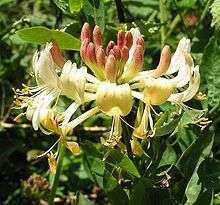Lonicera periclymenum
| Lonicera periclymenum | |
|---|---|
 | |
| Scientific classification | |
| Kingdom: | Plantae |
| (unranked): | Angiosperms |
| (unranked): | Eudicots |
| (unranked): | Asterids |
| Order: | Dipsacales |
| Family: | Caprifoliaceae |
| Genus: | Lonicera |
| Species: | L. periclymenum |
| Binomial name | |
| Lonicera periclymenum L. | |
| Synonyms[1] | |
| |
Lonicera periclymenum, common names honeysuckle, common honeysuckle, European honeysuckle or woodbine, is a species of flowering plant in the family Caprifoliaceae native to much of Europe. Growing to 7 m (23 ft) or more in height, it is a vigorous evergreen twining climber. It is found as far north as southern Norway and Sweden. In the UK it is one of two native honeysuckles, the other being Lonicera xylosteum. It is often found in woodland or in hedgerows or scrubland. The tubular, two-lipped flowers[2] are creamy white or yellowish and very sweet smelling (especially during the night). The plant is usually pollinated by moths or long-tongued bees and develops bright red berries.
In culture
Honeysuckle, or woodbine, has been a valued part of Britain's ecology for centuries. It is mentioned by Shakespeare:
- "I know a bank where the wild thyme blows,
- Where oxlips and the nodding violet grows,
- Quite over-canopied with luscious woodbine,
- With sweet musk-roses and with eglantine"[3]
British rock band Dire Straits mentions Honeysuckle in the opening lines of their 1980 song "Expresso Love":
- "She gets the sun in the daytime
- Perfume in the dusk
- And she comes out in the night time
- With a honeysuckle musk"
The plant was voted the County flower of Warwickshire in 2002 following a poll by the wild plant conservation charity Plantlife.[4]
Cultivation
L. periclymenum is one of several honeysuckle species valued in the garden, for its ability to twine around other plants, or to cover unsightly walls or outbuildings; and for the intense fragrance of its profuse flowers in summer. It needs to be planted with its roots in the shade, and its flowering top in sun or light shade. Plants need to be chosen with care as they can grow to a substantial size.[2] The cultivars 'Graham Thomas'[5] and 'Serotina'[6] have gained the Royal Horticultural Society's Award of Garden Merit.
Pests
Chromatomyia aprilina (honeysuckle leaf miner)
References
- ↑ "The Plant List: A Working List of All Plant Species". Retrieved 7 December 2014.
- 1 2 RHS A-Z encyclopedia of garden plants. United Kingdom: Dorling Kindersley. 2008. p. 1136. ISBN 1405332964.
- ↑ Shakespeare, William. A midsummer night's dream.
- ↑ Plantlife website County Flowers page Archived 2015-04-30 at the Wayback Machine.
- ↑ "RHS Plant Selector - Lonicera periclymenum 'Graham Thomas'". Retrieved 22 May 2013.
- ↑ "RHS Plant Selector - Lonicera periclymenum 'Serotina'". Retrieved 22 May 2013.
| Wikimedia Commons has media related to Lonicera periclymenum. |
| Wikispecies has information related to: Lonicera periclymenum |